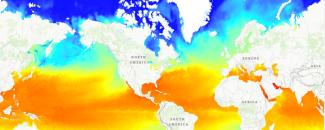Tracking Marine Heatwaves

Taking a dip in the ocean is an age-old solution to cooling down when temperatures soar. But when the ocean is abnormally warm, it does more than make it uncomfortable for a swim. Marine heatwaves can have significant impacts on ocean life including fishery collapse and coral death.
What are marine heat waves?
Marine heatwaves are usually defined as any time the ocean temperature is above the 90th percentile for five or more days in a row. This means that the temperatures are warmer than 90% of the previous observations for a given time of year.
Marine heatwaves can last for weeks, months, or years. From 2013–2017, a marine heatwave that became colloquially known as “The Blob” impacted the West Coast of North America from the Gulf of Alaska to Baja California in Mexico with devastating effects throughout the ecosystem.
Marine heatwaves are found all over the world, including in the Pacific, Atlantic, and Indian Oceans. A paper published in 2022, lead-authored by NCEI scientists, documented evidence of a growing number of marine heatwaves in the Arctic Ocean as well. But how do we know where and when these marine heatwaves are occurring? The answer is data.
Interpreting the Temperature Data
NCEI’s Daily Optimum Interpolation Sea Surface Temperature (DOISST) provides the global data coverage, blended data, and daily product production needed to identify marine heatwaves and track their intensity, duration, and areal coverage. DOISST also helps scientists identify marine heatwave trends such as the noted increase in the Arctic Ocean.
NCEI receives oceanographic data from all types of observing systems such as satellites in space, buoys moored to the seafloor, drifting buoys over the ocean surface, and drifting profiling floats. Each resource is valuable, and the data form one of the most significant archives on Earth. NCEI stewards the largest collection of sea surface temperature (SST) data in the world and uses that data to create essential products for the study of marine environments.
There are several types of SST products. Some are based completely on satellite observations which provide better spatial coverage but may have systematic biases. Others are based on in situ observations from ships, drifting buoys, and moored buoys. DOISST utilizes both. DOISST adjusts the differences between the satellite and in situ observations to compensate for platform differences and sensor biases. The analysis and associated map are routinely updated every day and have historic data dating back to 1981.
Multiple Uses
DOISST is publicly available for use by government, academia and the private sector, such as in the often media and press quoted Climate Analyzer tool. It has been incorporated into other products by NOAA and others. Scientists are learning more about marine heatwaves as more data become available.
DOISST is how NOAA’s Physical Sciences Laboratory monitors marine heatwaves. DOISST was also used to verify the performance of the experimental NOAA Marine Heatwave Forecast, which provides global outlooks of ocean heatwave likelihood up to a year in advance.
NOAA’s National Marine Ecosystem Status (NaMES) provides a snapshot of major U.S. marine and Great Lakes ecosystem indicators including marine heatwaves. The marine heatwave time series plots on this site are created from DOISST data and illustrate trends in regional heatwaves.
DOISST is one of the many integrated products that NCEI creates to support the broader scientific community.




